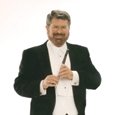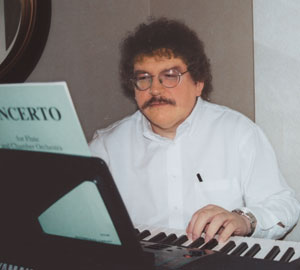 Eric Ewazen writes beautiful music, unabashedly melodic, singable tunes, with lush accompaniments. His Piccolo Concerto is a quintessential Ewazen composition with all the elements for an exquisite sonic journey. The story of how we agreed to the concerto commission is unusual. When I asked him for a trio sonata for piccolo, clarinet, and piano, I had played his woodwind quintet and heard his other trio sonatas and enjoyed what I heard. He immediately accepted the commission, but then asked if he could write a piccolo concerto for me. I was stunned. No composer had ever asked to do more, but not missing a beat I said, “Absolutely.” What a gift. I would get two pieces in two years. The trio sonata was completed for its première at the 2008 International Clarinet Fest held in Kansas City, and the concerto was premièred in August, 2010 at the National Flute Association Convention in Anaheim.
Eric Ewazen writes beautiful music, unabashedly melodic, singable tunes, with lush accompaniments. His Piccolo Concerto is a quintessential Ewazen composition with all the elements for an exquisite sonic journey. The story of how we agreed to the concerto commission is unusual. When I asked him for a trio sonata for piccolo, clarinet, and piano, I had played his woodwind quintet and heard his other trio sonatas and enjoyed what I heard. He immediately accepted the commission, but then asked if he could write a piccolo concerto for me. I was stunned. No composer had ever asked to do more, but not missing a beat I said, “Absolutely.” What a gift. I would get two pieces in two years. The trio sonata was completed for its première at the 2008 International Clarinet Fest held in Kansas City, and the concerto was premièred in August, 2010 at the National Flute Association Convention in Anaheim.
Concertos are usually in three movements, but this is a four-movement work. Usually each movement uses a motive as a building block for expanding musical ideas, but instead Ewazen used Felix Mendelssohn’s famous tune and poem On Wings of Song. The movement titles quote portions of the poem:
I. Over distant murmuring waves
II. Under serene moonlight
III. All earthly cares entwining
IV. Shall fade away in dreams
With these sentiments in mind, here are some ideas on how to present the music.
Tempo
Tempo might be the most important first decision when learning a new piece of music. A look at the first movement shows only the words Allegro leggiero. Without a metronome marking, the next step is to look at all aspects of the printed page. The orchestral part (piano reduction) starts with eighth note motion, and the piccolo melody is half notes and quarters.

Leggiero means light, swift, and delicate. The title, Over distant murmuring waves, and eighth-note movement in the accompaniment create the image of gentle waves of water, and the piccolo’s triplets drive the movement forward. Even though written in 3/4, the music reminded me of a Barcarolle, which is generally in 6/8. This tempo feels like one big beat per bar and two-bar phrases, as in a 6/8 meter. At this tempo the triplet becomes fairly quick, but if played in a leggiero manner, it has a pleasant “murmuring” effect.
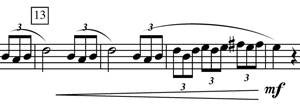
There is a trap beginning at bar 22 that consists of a triplet eighth rest and the five triplet notes that follow. Inevitably, performers will start the figure late at some point.
.jpg)
To avoid this tendency, take a large breath at 22 and try to take only one other breath before measure 33. Make sure that the quarter note at the end of each measure has a good solid vibrato and is sustained for the entire beat as written. The rest is not as important as a clear pickup to the triplets.
Dynamics
Dynamics give shapes and shadows to the music. In this movement they need to be subtle. Never let a diminuendo become so soft that the piccolo sound is lost. Remember, at all times the piccolo is the soloist. One measure before 33, play the quarter notes with lots of vibrato and not too loud. Avoid a crescendo to the high F. It will be too loud and disrupt the mood. At three before 44 however, use a good fat forte, and crescendo at 44 to the G. Be careful not to accent the starting note of the triplet figures and make sure that the F# at the fortissimo is not sharp.
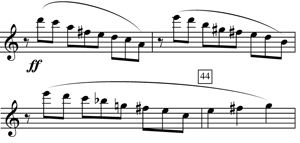
Throughout the movement be vigilant and keep the tempo moving. The tendency is to slow down. When practicing, check the metronome often. At measure 253 you will want to let loose with your sound, but resist the temptation and look to 266.
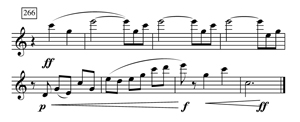
That is the finish of the phrase and the tag ending of the movement. Let the orchestra make the crescendo. You might get lost in the orchestra’s sound here, but that is okay. It is the end.
As Ewazen wrote the piece, I received the movements from him one at a time. I became convinced that tempo choices and their relationship to the tempos of the previous movement were very important. Even though he probably didn’t think of it consciously, it is quite clear in the music. It is a perfect case of the creative spirit moving in mysterious ways.
II. Andante teneramente
The second movement also has no metronome marking, and I am hesitant to set one for fear that it will become gospel. However, and just for clarity, the quarter note of the first movement equals the quarter note of the second movement, which is about m. 126. This movement is expected to be serene, and its form seems to be much more romantic than the first movement. It should have some rubato, not much, and be subtle at all times, but definitely not static.
The first gesture at measure 8 should have a small tenuto on the first note. The following B flat should have lots of vibrato and move forward to the next note. This gesture can be accomplished with a slight crescendo to the A in measure 10, but don’t make too much of the diminuendo to the C.
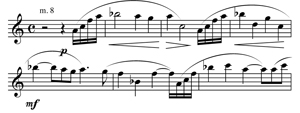
The pickup to measure 11, the same music as before, should be a little different, so here I make the tenuto on the last 16th note. Then with a beautiful sound complimented by vibrato, lead to the B flat in measure 12 and continue the line with full sound through the A. The eighth-note G starts developing the motive, so carefully use your dynamic range to end in measure 18 with a full sound at the end of the phrase. To keep interest in the melody and let the audience know where we are headed is the most difficult part of this movement.
The music changes at measure 24 and becomes rhythmically reminiscent of the first movement.
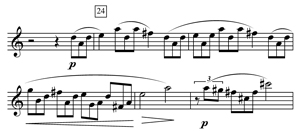
Here I take a new tempo, a little faster and once again use tasteful tenutos. Too many times I have heard students, and sometimes professionals, put tenutos on each beat. This is a false phrasing and should be avoided at all cost. The tenuto is a wonderful device to show balance, outline a note, and let the listener hear the inner melodies. Overuse it and it becomes meaningless, showing a lack of musical phrasing and creative ideas.
I also feel these measures in two, even though the tempo is slow, which gives the pulse of this section’s accents on one and three. Once again, don’t be afraid to move ahead and slow down when needed. Make it musical and in good taste.
Measure 76 restates the musical material from the beginning. Some of the triplets are articulated this time, and the articulations must be audible. Make a space between the notes. There is also a single slur from 79 to the fourth beat of 83, although the corresponding music at 12 had a break.
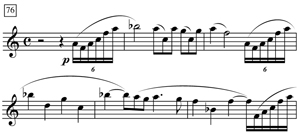
Now the phrase is even longer and more problematic. Breathe before the pickups in measure 78 and play all the way through 81 without a breath. To take a breath on the fourth beat of 81, release the tied note a bit early. Make it an eighth note, and use a tenuto on the pickup F for a seamless phrase.
The end is difficult because you will probably be out of breath, tired, and emotionally spent. Tempo is the key to the music from 90-100. Don’t slow down. The audience is also looking to sigh and relax. The melody will be emotional for them as well. Keep moving and crescendo to measure 99. If you are out of air or the D becomes flat, just diminuendo and let the orchestra make the niente ending.
III. Allegro energico
After the angst and emotional turbulence of the first two movements, the third movement becomes the centerpiece of the concerto. Once again it is tempo that will make the statement, and the emphasis must be on the energico. The quarter note of the second movement becomes the dotted quarter of the third movement. The orchestra starts with a series of equal 16ths, and the piccolo enters with a hemiola. That three against two figure will sound faster than the tempo, so avoid slowing down in measure 5. If anything, push the tempo without rushing. This will keep the tension up and show all the changes to come.
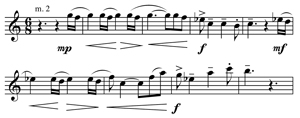
Articulation is extremely important in this movement. The speed will blur notes if the articulations don’t have spaces between them. The quarters in the third measure should only be sustained the length of an eighth note, and each 16th-note G should have just enough of an accent to kick the next rhythm. Measure 5 requires very specific tonguing: an accented 8th note followed by two-quarter notes with tenutos. These quarters should have space between them to bring out the syncopated rhythm. Hold the sustained dotted-quarter C in measure 6 full value. This type of articulation is complicated and should be one of the exercises you practice. It is tricky at times, but the listener does hear the difference. Without these details, the passage is bland and musically flat.
Measures 33-39 are fraught with danger. Do not let the orchestra (or band or piano) slow down. They will want to wait. Practice the rhythm with a metronome by playing an eighth in place of the eighth rest in each figure.
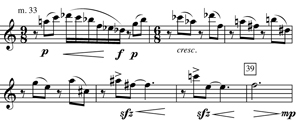
When you feel you have conquered the tempo, leave out the added note, and “play” the eighth-rest. Make sure you stay in tune on the sforzandos during the crescendo. There is a siciliana rhythm pattern at 56; avoid slowing down there. Make it sprightly, unlike the slow pedantic form of the 16th-century dance you often hear.
The Allegro furioso section that begins at 85 must have a minimum tempo marking of quarter =144 and stay at that tempo; you can even push a little to propel this section. Be sure the articulation is clear in measure 94 and similar places. The rhythmic pattern in 101-102 and the subsequent music that follows is unexpected and therefore tricky. Both soloist and ensemble must count and play on top of the beat. Use a very short staccato so each voice is heard. At that speed, anticipation is a virtue.
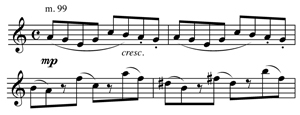
The Lento at 145 is slower, but make it organic and part of the flow of the previous music. It should change tempo gradually to arrive at the L’istesso tempo of measure 147. The accelerando that follows becomes fast and furious. The last measure comes as a relief, and you will want to explode on the E3 trill. Don’t! Always keep control of the sound and don’t allow the E3 to go sharp. Place the last note by making a space between the trill and the C. That will make the end sound clear.

IV. “Shall Fade Away in Dreams”
This is by far the easiest movement to play technically, but one of the hardest to play musically. The beginning must be pp, as soft as can be heard, and have a beautiful, singing voice about it. Remember my admonition: Always use vibrato. Just because it is soft doesn’t mean to squeeze the sound. Open up the air passage, use less air and more vibrato; the sound should shimmer underneath the ethereal tremolos. The crescendos are really a reminder to be musical, so let the sound rise naturally all the way through measure 16. Crescendo to the C3 but make a slight teardrop to end the solo.

This entire movement is a variation on “The Wings of Song,” so the tempo of this movement should be a half note equals the quarter note of the first movement. Keep the feeling of two beats per bar to number 16. At 24, Andante con moto, the meter changes to 3/4, and the previous half note now equals a full measure or a dotted-half note.
Maintain a lilt to the music, which should never be rushed but always move as water underneath a gondola. Avoid the tendency to slow down in quarter-note melodies. If you want a little rubato somewhere or a tenuto to bring out a note, do not do it on quarter notes. Good places for tenutos are at 32 and again at 36. Don’t overdo the expressive gestures.
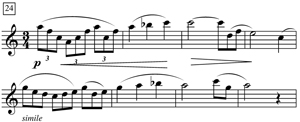
As in Baroque music, the fewer ornaments you use the more effective they will be, and since this variation is actually an ornamentation of the original melody, anything added is also an ornament.
At 40, start at mf and show the change of harmony with a little rubato. When the music repeats in measures 44-47, begin softly to produce an echo and make a smaller crescendo than you did in 42 and 43.
I disagree with the pp dynamic at 50. Use your best and most luscious low register sound and bring out all the woodiness of the piccolo you can muster. End the phrase segment on measure 53 and treat the C in 53 as a pickup to 54. I believe the two low Fs in 52-53 should be slurred, just as the two Gs are in 56-57.
The musical gestures at 69 are difficult and will require extra practice. The piccolo part is misleading because of the p subito and accelerando and crescendo markings. The subito applies only to the dynamic, not the accelerando. To make this four-bar accelerando and crescendo work, each beat should get gradually faster and louder. The accelerando should feel comfortable, not rushed, and the crescendo is only to forte. Everything about this passage should be controlled so that you arrive at the tempo of the first movement.
The same control is necessary in measures 105-109, as the ritardando gently slows to the Andante con moto tempo of measure 24. The ending ritard should really start one measure later than marked with a healthy accelerando from the orchestra and a full ritard on the last beat for a convincing ending. As marked, make a crescendo in the next to last measure on the last part of the last beat followed by a full diminuendo to end the piece.
Playing Piccolo Concertos
Before 1985 there were only four piccolo concertos that were widely known: the three Vivaldi concerti and one by Will Gay Bottje. That means that piccolo players never developed the art of concerto playing. Although all piccolo players played flute, the performance ability never seemed to transfer from the flute to piccolo. Now is your chance to practice a soloistic sound, such as a cellist or a violinist might have. The sound should be bigger and louder but not shrill, than when you play in an orchestra, band, or small ensemble.
Piccolo players often seem afraid of the instrument. When trying to play softly, they squeeze and turn in, as though the piccolo is a loud instrument. It is not. When played poorly or by a beginner, it can be shrill in the upper register, but it need not be that way. Approach the piccolo as an instrument that can be expressive and have a pleasant, beautiful sound.
Most of the unpleasantness of playing piccolo comes from flutists’ inability to play the piccolo in tune. Most have conquered intonation on flute, but don’t have a clue about how the piccolo works. Piccolo fingerings are not the same as those for flute; the acoustics are very different, so it is unreasonable to think that flute fingerings will work on piccolo. Find out which fingerings are different and why, and your quest for good intonation will be much easier.
Playing the piccolo is harder work than playing flute. You must always control the air column to avoid overblown notes, especially in the upper octave. Learn to use only enough air to get the note to speak and practice making it a beautiful sound. As on flute, the sound should be even throughout the three octaves.
Playing a concerto is hard work. The movements are usually longer than any solo passage that you have played in an ensemble. Condition yourself so you can play the entire piece at your best level. Before performing a piece, I play it through two or three times a day, one right after another, just for stamina. I also have to play at full voice at least one hour before the performance to make the muscles ready. Then I can start with a full sound.
Don’t start the performance by tuning and noodling in front of the ensemble. Warmup and tune beforehand. You should know where the pitch will be from the rehearsals, so a touch will make sure it is still in the neighborhood and your instrument hasn’t lost a pad between the green room and the concert stage.

